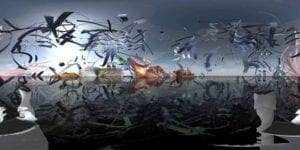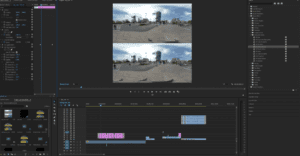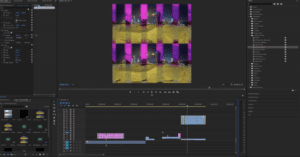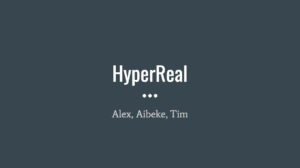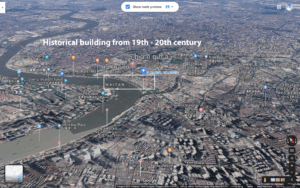Promising trends:
1. Facebook’s DeepFovea AI promises power-efficient VR foveated rendering.
This semester we witnessed Google announce the end of its phone-based VR grand trial, which essentially discard its efforts with the cardboard and Daydream projects. Two of the major reasons behind the low adoption rate, I believe, are the relatively low resolution and high power consumption. Thus, the research on foveated rendering becomes the focus of many VR firms, since it promises to provide high resolution for areas where the user pays attention to and achieve that with lower energy consumption and probably less latency. This technology, along with other power-saving improvements, is critical in building wearable VR/AR devices.

Source: DeepFovea
2. Apple Working on AR Headphones
While most of the AR companies out there compete in fooling the eyes, the world of spatial audio augmentation receives less attention. The patent Apple recently filed shows the firm’s ambition in building AR headphones that could spatialize sound in a video/voice conference setting. This use case could have great potential for business customers but also for public spaces like museums and schools. Also, compared to the complex optical requirements to create AR visuals, AR audio seems a low-hanging fruit that would hit the market in the coming five years.
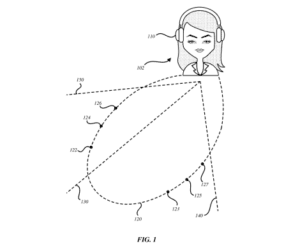
Source: USPTO
3. Microsoft’s DreamWalker lets you see VR cities during real-world walks
This invention might seem weird at first glance: having the user see a VR city rendered by detecting the real-world city environment looks like a redundant step, especially considering the rough CGI models and blurry textures. However, I think this signals a potential use case which has a huge customer pool: commuter recreation. As cities expand, an increasing number of people need to take a long commute to work every day. People might read and watch videos on their smartphones, but a VR experience during the commute would definitely make the previously boring commute something to look forward to. A modified train cabin that allows travelers to safely experience VR during their commute would be very interesting.

Source: Microsoft Research
4. Create An Entire Home Gym With Oculus Quest
Another piece of news that I believe shows a promising commercial trend. It demonstrates how in less than $ 600 one can build his/her own VR gym at home. The vested weight and other accessories could be deliberately designed in the gym VR titles so that the experiences are better. Considering there is a growing demand in China for gym and fitness training, and that many physical gyms are run inefficiently and shut down soon after they open, people would probably show more interest in home gym options.
Not so promising trends:
1. Facebook’s Latest Purchase Gets Inside Users’ Heads—Literally
I used to believe that the brain-machine interface is an important step towards intelligence augmentation, IA (an idea that focuses on strengthening human intelligence instead of replacing it with machine intelligence). Facebook’s acquisition of CTRL-Labs gives me mixed feelings. Even though the tech giant claims the interface only enables users to give instructions to applications and collect no more information, the idea that one can share some photos or information by just “intending to” is unsettling. The ease of sharing encourages leakage of private information that users might not want to publish given a second chance to think about it. This brain-machine interface could be useful in many cases, but it should be heavily regulated in a social network application.
2. Russian dairy farmers gave cows VR goggles with hopes they would be happier and make better milk
This piece of news sounds like a joke but I think it suggests a possibility that VR headsets and related technology could be cheap enough one day to become a tool to make tedious work more tolerable. However, the value it brings to its users (cows in this case) might not be “real” and substantial. Though the cows see an ideal living environment in VR, their real living conditions are not any better. Calmed by the virtual reality, they may be confined to even smaller space physically. Such kind of virtual experience is more like a means of control, which should not be encouraged, no matter its audience is animals or humans.

Source: Ministry of Agriculture of the Moscow region
3. MediView XR raises $4.5 million to give surgeons X-ray vision with AR
The startup company is working towards a mixed reality solution for tumor removal surgeries. Despite the good intention and help it provides, I am not sure if it is reliable enough for real surgeries. Medical use cases are high stake scenarios and inaccurate AR projection could lead to legal mistakes. Even if we assume the AR imaging is correct, surgeons who get used to having AR assistance might find it hard to perform the operation when AR is not available due to technical reasons. A better use case might be medical personnel training, meanwhile, the technology should go through rounds of checks to confirm its accuracy.
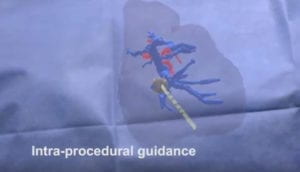
Source: Mediview
4. Virtual Reality is the latest dinner party trick
Appealing as the news title sound, the dining experience described in the news piece is far from a casual and fun dinner party. The VR environment was somewhat avant-garde, featuring an abstract and artistic environment that don’t arouse my appetite. The unusual container of food and the bite-size limitations also makes the food more of a tool in an exotic VR experience, rather than a food itself. The news is reporting a trend that food served in such experiences is going high-end, with top chefs joining the team. However, I think a more popular use case might be creating VR representations of snacks for VR gamers or movie views who want to enjoy snacks while experiencing VR. It will be a natural extension of the VR environment instead of transporting the user to a random place and alienizing the food itself.
